Excerpts from Jim Conrad's
Naturalist Newsletter
entry dated September 4, 2022, issued from near Tequisquiapan, elevation about 1,900m (6200 ft), N20.565°, W99.890°, Querétaro state, MÉXICO
MARIOLA

On the lower slope of a gently sloping, much overgrazed and hacked-over, sadly eroded hill vegetated with low scrub and weeds, the much-branched, woody, waist-high shrub shown above was in full flower and looking healthy. It was the only plant of its kind in the neighborhood, and pollinators were busy among its blossoms.
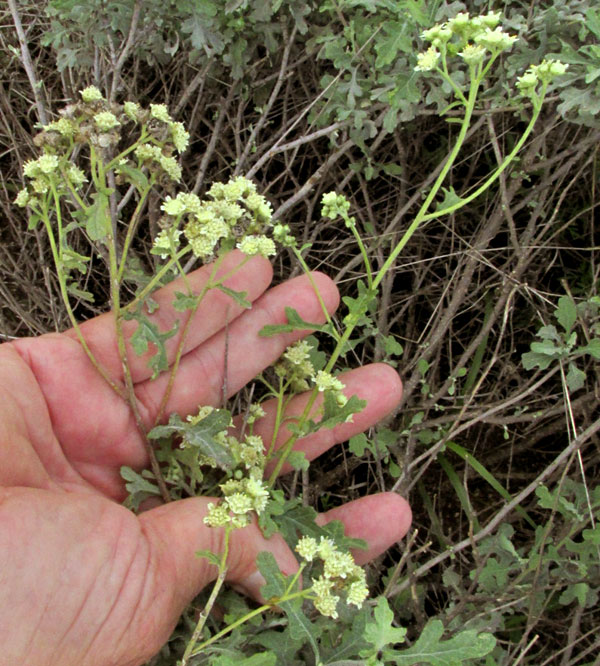
Its flowering heads were small and its soft-hairy vegetative parts were pale, grayish green. When I took hold of the above branch to keep it steady in the wind as the photo was taken, a sharply pungent medicinal odor suffused the air.
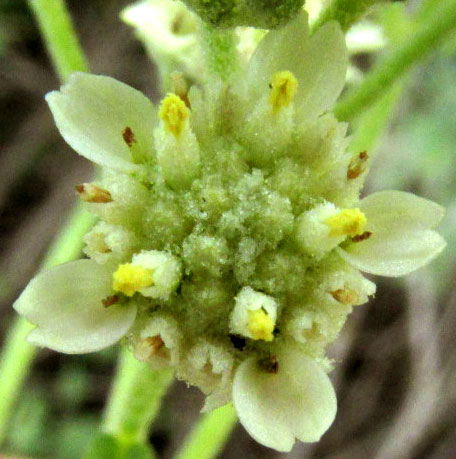
With the flowering head, or capitulum, composed of tiny disc florets with cylindrical corollas packed together tightly in the center, and petal-like ray florets with broad, scoop-shaped corollas radiating from the head's perimeter, the bush was clearly a member of the vast Composite or Aster Family, the Asteraceae. Moreover, the combination of the capitulum's small size, its creamy-white color, the mealy hairiness mantling certain parts, and the very short, scoop-shaped ray florets, it was too similar to flower features of the abundant, herbaceous, annual weed known as Feverfew, Parthenium hysterophorus, to be coincidental. This was surely a woody species of Parthenium. Feverfew often is called Wild Quinine, reflecting its medicinal qualities, so that fits in with our woody bush's medicinal smell.
However, the huge Aster Family is full of surprises, so with any newly-met species, to be sure of the identity, you need to "do the botany."
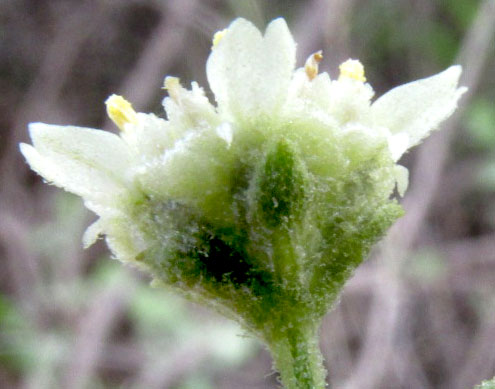
Above, the green, soft-hairy involucre at the capitulum's bottom consists of only five phyllaries, unusual in the Aster Family, but exactly as with Feverfew.
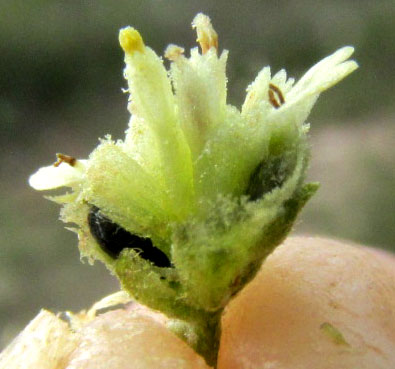
Above, the broken-open capitulum displays a black, cypsela-type fruit developing on each side, but there's no hint of such cypselae beneath disc floret corollas. This is as expected, because in the genus Parthenium disc florets are sterile, their yellow anthers producing only pollen. Cypselae are formed only along the capitulum's margin, by ray florets.
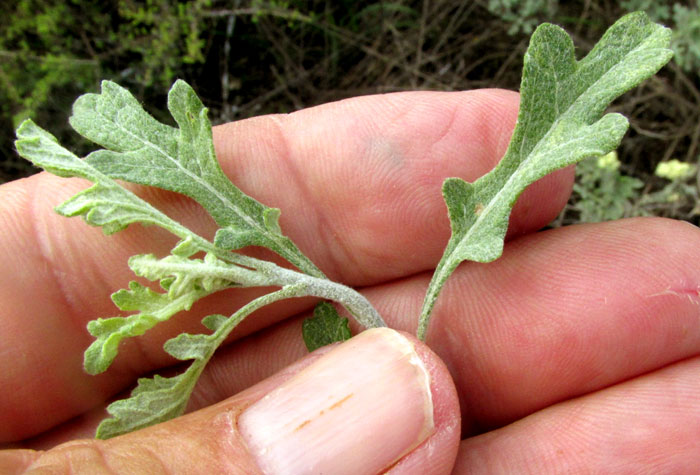
Finally, even our bush's leaves are similar to those of the herbaceous Feverfew, just not as deeply lobed.
The genus Parthenium is strictly native to the New World, though some species have been introduced elsewhere. The 16 or so Parthenium species mostly are distributed in warm-temperate and tropical regions. Here in Querétaro state in upland central Mexico, about six species have been documented. And here, if you have a woody, bushy Parthenium with 2-3 rounded lobes on each side of the leaf, with the valleys between the lobes not reaching the midrib, you have PARTHENIUM INCANUM.
Parthenium incanum in English usually is referred to by its Spanish name, Mariola. Mariola is a conspicuous and ecologically important presence in much of the US desert Southwest, as well as drier parts of northern, central and southwestern Mexico.
In the US, Mariola is cultivated as an ornamental in gardens designed around native plants that are tolerant to drought and useful to wildlife. A Wikipedia article cites a report that the Apache people traditionally used it medicinally, boiling the shrub's leaves for a solution that was rubbed over pregnant women's abdomens to relieve discomfort. The Mariola's page at the TexasBeyondHistory.Net website {used to mention and show} a carefully folded and dried Mariola plant recovered from the Fate Bell Shelter archaeological site a bit northwest of Amistad Lake near Del Rio, Texas, suggesting the importance of our plant to earlier people.
The online Atlas de las Plantas de la Medicina Tradicional Mexicana reports that in traditional Mexican medicine a hot Mariola tea has been used to treat various stomach ailments, including diarrhea, and especially the bilis, which is stomach problems mostly caused by emotional stress of various kinds. Also Mariola is used for liver problems. The odor of the plant's leaves seems to communicate to anyone smelling it that it'd be good for an upset stomach. It's something like the odor of wormwood or absinthe, which seems to have helped my own upset stomachs.
The most famous of all members of the genus Parthenium is Parthenium argentatum, known as Guayule. Guayule at various moments in history has been used for the production of natural rubber derived from latex obtained by crushing the shrubs. Today it's useful in producing hypoallergenic (low allergy-causing potential) rubber articles. Wikipedia has a section on the history of natural rubber from Guayule. Genetic studies indicate that our Mariola is the "closest sister species" to Guayule -- the two taxa evolved from the same ancestor, thus share more genetic information with one another than with any other species. Our Mariola also produces latex that can be used to produce natural rubber. However, Michael Powell in his 1998 Trees and Shrubs of the Trans-Pecos and Adjacent Areas informs that Guayule produces 8-20% rubber, while Mariola yields only 2-3%.
Maybe the most important contribution Mariola makes to its neighboring living community is that it survives in very abused, abandoned land, not only stabilizing eroding soil with its extensive root system, and adding organic matter to the soil with its leaf fall, but also offering abundant nectar and pollen to pollinators.